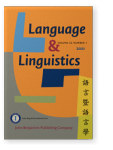Vol. 22:1 (2021) ► pp.111–166
Exhaustivity and bare numeral phrases in Mandarin
A well-known generalization about bare numeral phrases (BNPs) in Mandarin is that they tend to require the existential verb you ‘have’ when in subject position, but there are some notable exceptions. This paper concentrates on the data cited by Li (1998) and proposes an Exhaustivity Condition according to which a subject BNP is felicitous if and only if it is interpreted exhaustively. It is shown how this condition generalizes to all the constructions under discussion, while at the same time they each belong to a particular type of quantificational construction or another (cumulativity, scalar focus, sufficiency, or conditional). I argue that the close relation between Mandarin subject BNPs and exhaustivity not only explains the restricted distribution of the former but also enables us to account for their so-called quantity readings in terms of exhaustive interpretation. Comparisons of the proposal with previous approaches will also be discussed.
Article outline
- 1.Introduction
- 2.Previous analyses
- 2.1
Li 1998
- 2.1.1The NumP hypothesis
- 2.1.2Discussion on the NumP hypothesis
- 2.2
Tsai 2001
- 2.2.1The extended mapping hypothesis
- 2.2.2Discussion on the extended mapping hypothesis
- 2.3
Lu 2004
- 2.3.1The carlsonian analysis
- 2.3.2Discussion on the Carlsonian analysis
- 2.1
Li 1998
- 3.Proposal
- 3.1Alternatives and focus interpretation
- 3.2Cumulativity and exhaustivity
- 3.3Association with focus particles
- 3.4Sufficiency and exhaustivity
- 3.5Conditionals and exhaustivity
- 3.6Some notes on “individual-denoting” BNPs
- 4.Other cases of exhaustivity
- 4.1Contrastive topics
- 4.2Distributivity
- 4.3Double singular BNPs
- 4.4Question-answer congruence
- 5.Comparison with previous accounts
- 6.Concluding remarks
- Acknowledgements
- Notes
- Abbreviations
-
References
For any use beyond this license, please contact the publisher at [email protected].
